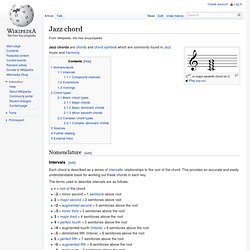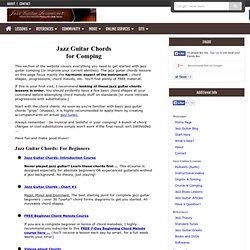

Learning and Loving Music Theory. Kelvin, You actually caught a mistake on the roman numerals!

Thanks, I’ll have to fix that. The first and last chords of the progression are not 7th chords. Somehow I inadvertently typed “I7″ on the first chord of all the major keys. (Notice that I didn’t do that for the minor keys.) In the classical tradition, for the sake of stability, the first and last chords of a circle-of-fifths progression are usually triads, not 7th chords. Harmonic Sequences Part 2 In the jazz tradition all chords usually are 7ths, in which case the progression will start and end with 7th chords.
Thanks again for your interest and input. List of chord progressions. The Harmonic Language of Jazz Standards. Have you ever met a player who can seemingly play any song in any key, coming up with different chord substitutions on every chorus?

If you have been playing for a while but thought this skill was something magical and beyond you, then this book is for you. What allows players to do these things is the ability to recognize and understand common chord progressions and to reproduce them by ear as easily as one can play melodies by ear. This is a skill that you too can learn! After mastering the concepts explained in this book, you will find you are able to play by ear, in any key, with appropriate chord changes, any standard you know well to hum. You will also be able to make a variety of different substitutions while playing, and you will also see improvements in your your improvisation and composition abilities. Please realize this is not some gimmick I am promoting – I am talking about learning sound theoretical principles. Musical Analysis - detailed musical analysis of jazz and modern classical masterpieces.
Share Jazz Giant Steps, Central Park West, and Modulatory Cycles John Coltrane wasn’t the first to experiment with equal subdivisions of the octave (experiments go back to at least 1825), but his Giant Steps placed this radically different approach to harmony front and centre within the jazz world.

Its unusual beauty and power still exert an influence, half a century later. However, in our fascination with the what of Coltrane’s octave subdivision, we can at times forget that its how is equally important. Both Giant Steps and Central Park West were constructed using its methods, and yet these classics couldn’t be more dissimilar in tone and artistic effect. This analysis explores those discoveries, as they are embodied within the techniques used to create these masterpieces. Danny Grissett: invention, design, and technique A condensed version of this article first appeared in the April, 2010 issue of DownBeat Magazine. Just Friends Rising Sun Modern Classical L'Histoire du Soldat. ThinkingHarmony - in-depth discussions of jazz and classical harmony. Share The device of presenting ideas within the framework of a student-teacher conversation goes back at least as far as Plato, and probably beyond.

But thinkingMusic is itself a platform for presenting ideas, so why this ploy? While thinkingHarmony may appear to use this device, it's actually the real thing: a selection of email conversations that have taken place between my students and me, as part of our ongoing, long-distance lessons in classical and jazz harmony. Rather than use a teacher-student framework as a vehicle for my ideas, my intention is the reverse: to show that long-distance instruction can be deeply effective and enjoyable, given the right mix of technology, creativity and personal style. These email conversations take place between me and “Gustave M.”. Jazz chord. CΔ7, or major seventh chord on C Play .

Nomenclature[edit] Intervals[edit] The terms used to describe intervals are as follows: r 3 5 contains the root, a major third above the root and a perfect fifth above the root (major chord). Jazz Progressions. Jazz Progressions are simply common chord progressions in jazz music.

One of the most common progressions is the ii-V-I progression. The ii-V-I sounds at its best when you use seventh chords and their expanded voicings. As you already know from past lessons, the ii chord is a minor chord, the V chord is a dominant chord, and the I chord is a major chord. So the most basic Jazz progression is the ii minor 7 - V dominant 7 - I major 7. Berklee Chord Game. Jazz Chord Primer. Drop 2 Chords for Jazz Guitar. II-V-I Tutor - Drop 2 and Drop 3 Voicings. Drop 2 Voicings. Drop 2 voicings are formed by taking a chord and then dropping the next to the highest note, or voice, to the lowest note of the chord.

Similarly, there are drop 1, drop 3, drop 2 & 4, etc. Drop 2 voicings are important because most of these chords are easy for a guitarist to play on 4 adjacent strings. Drop 2 is just a name for how the chords were derived from another chord. This is only important for naming the voicings. I will describe how they are derived then I will show you the voicings.
The example below shows four C Major 7 chords and their drop 2 voicings in standard notation. Jazz Guitar Chords: Learn comping (accompaniment), harmony and chords. This section of the website covers everything you need to get started with jazz guitar comping (or improve your current abilities).

The jazz guitar chords lessons on this page focus mainly the harmonic aspect of the instrument : chord shapes, progressions, chord melody, etc. You'll find plenty of FREE material. If this is your first visit, I recommend looking at these jazz guitar chords lessons in order. You should evidently have a few basic chord shapes at your command before attempting chord melody stuff on standards (or more intricate progressions with substitutions.) Start with the chord charts. Always remember : be musical and tasteful in your comping!